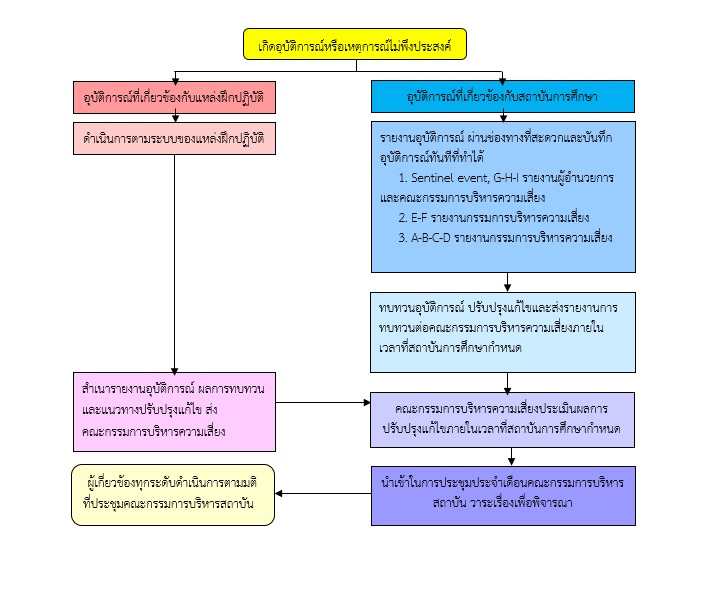การบริหารความเสี่ยงในการฝึกปฏิบัติการพยาบาล
คำสำคัญ:
การบริหารความเสี่ยง, ความเสี่ยงในการฝึกภาคปฏิบัติ, การฝึกปฏิบัติการพยาบาลบทคัดย่อ
การจัดการศึกษาพยาบาล เป็นส่วนหนึ่งในการปฏิบัติตามมาตรฐานโรงพยาบาลและบริการสุขภาพด้านการจัดการด้านการเรียนการสอนทางคลินิก ที่กำหนดให้มีการกำกับดูแลที่เพียงพอในแต่ละระดับของผู้เรียนและผู้รับการฝึก เพื่อให้มั่นใจในความปลอดภัยขณะดูแลผู้ป่วย และได้รับประสบการณ์การเรียนรู้ที่ใกล้เคียงกัน และปฏิบัติตามระบบบริหารความเสี่ยงและความปลอดภัยที่มีประสิทธิผลและประสานสอดคล้องกันในทุกระดับ จัดการความเสี่ยงและสร้างความปลอดภัยแก่ผู้รับบริการ เจ้าหน้าที่และผู้มาเยือน เนื่องจากผู้เรียนต้องปฏิบัติการพยาบาลผู้ป่วยในขณะที่ยังมีความรู้ ทักษะและประสบการณ์ไม่เพียงพอที่จะดูแลได้อย่างมีคุณภาพ ผู้เกี่ยวข้องกับการจัดการศึกษาจึงต้องบริหารความเสี่ยงในการฝึกภาคปฏิบัติ โดย 1) ทำความเข้าใจนิยามศัพท์ที่เกี่ยวข้องกับการบริหารความเสี่ยงเพื่อการดำเนินงานอย่างเข้าใจ 2) กำหนดโปรแกรมความเสี่ยงครอบคลุมระบบงานที่เกี่ยวข้องกับการฝึกภาคปฏิบัติ และวิเคราะห์และค้นหาความเสี่ยงในแต่ละโปรแกรม นำมาจัดทำบัญชีความเสี่ยง กำหนดมาตรการป้องกันและควบคุมกำกับ 3) จัดระดับความรุนแรงของความเสี่ยงเพื่อใช้ประเมินความเสี่ยงหรือความเสียหายที่เกิดขึ้น 4) กำหนดขั้นตอนการบริหารความเสี่ยงและการรายงานอุบัติการณ์ รวมทั้งกำหนดรูปแบบการรายงานอุบัติการณ์ และข้อตกลงเบื้องต้นในการรายงานอุบัติการณ์เพื่อการเรียนรู้และแบ่งปันบทเรียนที่จะนำไปสู่การเปลี่ยนแปลงระบบงาน แนวทางนี้เป็นวิธีการหนึ่งที่ช่วยให้การฝึกภาคปฏิบัติบรรลุเป้าหมายคุณภาพและความปลอดภัย และวัตถุประสงค์การเรียนรู้ได้อย่างมีประสิทธิภาพ
เอกสารอ้างอิง
American Nurse Association. (2016). Culture of Safety. Retrieved from https://www.nursingworld .org/practice-policy/work-environment/health-safety/culture-of-safety/
Fukfon, K., Sriwichai, P., Chairinkhom, S., & Tanyapansin, P. (2018). Stress and Factors Related
to Stress of Nursing Students Regarding the First Clinical Nursing Practice. Nursing Public Health and Education Journal, 19(1), 161-168. (in Thai)
Health Care Accreditation Institute. (Public Organization). (2015). WHO Patient Safety Curriculum Guide: Multidisciplinary Code. (Thai). Nonthaburi: D-ONE BOOKS. (in Thai)
Health Care Accreditation Institute. (Public Organization). (2019). Hospital and Health Care Standard 4 th edtion. (2nd edition). Nonthaburi: D-ONE BOOKS. (in Thai)
Kumkong, M. (2019). Patient Safety: A Guideline to Nursing Practicum. The Southern College Network Journal of Nursing and Public Health, 6(1), 216-228. (in Thai)
Kumkong, M., & Aramrom, Y. (2020). Risk Management of Nursing Practicum among Nursing Students. In Kumkong, M. (Ed.). Nursing Education with Nursing Practice for Safety. Songkhla: Tem printing. (in Thai)
Mahidol University Faculty of Medicine Ramathibodi Hospital. (2017). Risk Management. Retrieved from https://med.mahidol.ac.th/risk_mgt/th/article/03212017-1509 (in Thai)
Philalai, T. (2017). Risk Management in Nursing. Retrieved from https://ramanursealumni. mahidol.ac.th/sites/default/files/public/Torranong%20170824%20Risk%20Management%20in%20Nursing%20%2540Ramathibodi_for%20Handout_PDF.pdf (in Thai)
Sriboonpimsuay, W., Srisutipanporn, S., & Phanich, P. (2016). Stress and Copping Prior to Practice in Labour Room of the Third-Year Nursing Students at Boromarajonani College of Nursing Udonthani. UMT Poly Journal, 13(2), 30-38. (in Thai)
Sirinakorn, R. (2014). Risk Management. Short Course Training Handout of Prevention and Infection Control in Hospital. Retrieved from file:///C:/Users/malee/Downloads /Risk%20%20management(1).pdf (in Thai)
Upanan, P. (2017). Enterprise Risk Management. Retrieved from https://med.mahidol.ac.th/ risk_mgt/th/article/03202017-1523 (in Thai)
Wanapirak, C. (n.d.). Adverse Event Review: Trigger Tools. Retrieved from
https://www.chiangmaihealth.go.th/cmpho_web/document/190606155979674918.pdf (in Thai)
Yodthong, S., Sanee, N., & Chansungnoen, J. (2018). Stress and Coping among Nursing Students in Principles and Nursing Techniques Practicum, Boromarajonani College of Nursing, Trang. The 9th Hatyai National and International Conference. Retrieved from
http://www.hu.ac.th/conference/proceedings/data/%.pdf (in Thai)

ดาวน์โหลด
เผยแพร่แล้ว
ฉบับ
ประเภทบทความ
สัญญาอนุญาต
1. บทความหรือข้อคิดเห็นใด ๆ ที่ปรากฏในวารสารเครือข่าย วิทยาลัยพยาบาลและการสาธารณสุขภาคใต้ ที่เป็นวรรณกรรมของผู้เขียน บรรณาธิการหรือเครือข่ายวิทยาลัยพยาบาลและวิทยาลัยการสาธารณสุขภาคใต้ ไม่จำเป็นต้องเห็นด้วย
2. บทความที่ได้รับการตีพิมพ์ถือเป็นลิขสิทธิ์ของ วารสารเครือข่ายวิทยาลัยพยาบาลและการสาธารณสุขภาคใต้







